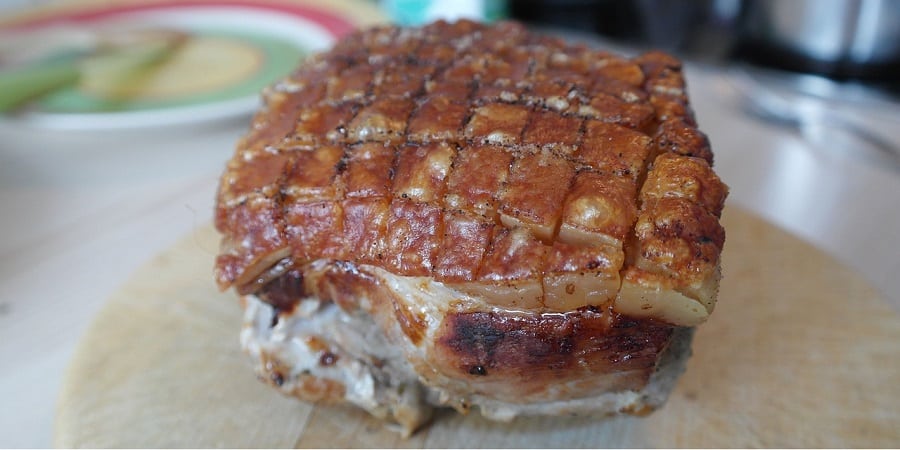Like most other European nations. Norway has its own Christmas foods and traditions. While there is a great deal of overlap, especially between the Scandinavian countries and northern Europe, Norway has its own traditional Christmas food.
Christmas is celebrated with a traditional dinner on Christmas eve. What kind of meal is prepared depends on what region you are in. In Østlandet (Greater Oslo area) you typically eat Ribbe (roasted pork belly). In Vestlandet (Western Norway) the most common is Pinnekjøtt (cured lamb ribs). In certain areas of Sørlandet (Southern Norway), it is common to eat Christmas cod.
These regional differences have their roots in geographical differences and traditional agricultural policies. Other typical Christmas foods and drinks include traditional Christmas beer, lutefisk, rakfisk, and akvavit. Here are 11 of the most traditional Norwegian Christmas foods/drinks

Ribbe (Roasted pork belly)
Norway’s most popular Christmas food, which is consumed by more than half of the population on Christmas eve. Its origin comes from the agricultural policy that grain production and pig farming be centralized to the plains of southeastern Norway, which resulted in an abundance of pork compared to the rest of the country.
The pork belly is prepared in the oven without being cured. There are many different ways to prepare it, but the most important and prestigious detail is to make the skin side crispy.
To make the meal complete, Ribbe is typically served with medisterkaker (Christmas meatball), Christmas sausage, almond potatoes, brown sauce, and pickled red cabbage.
Pinnekjøtt (Cured lamb ribs)
Pinnekjøtt is the second most popular Christmas meal. It originates from Western Norway, where goat herding/farming was common due to agricultural policies.
It gets its distinctive taste from being salted and smoked before its final preparation. This includes removing some of the salt by placing it in water before boiling or steam cooking it, during which birch sticks are placed at the bottom to prevent the meat from sticking.
While the garnish can vary, it is typically served with swede mash, potatoes as well as a dash of lingonberry jam. Another typical garnish is Vossakorv (a traditional sausage from Voss).
Lutefisk
This special meal is actually dried white fish (typically cod) which is then pickled in lye. While no one knows the origin or why one chose to prepare the fish with lye, Its consumption can be documented all the way back to the 16th century.
It has no regional affiliation and is enjoyed all over the country. The garnish can vary, but It is typically served with potatoes, pea stew, and bacon.
Christmas Cod
This tradition lives on from the days before the protestant reformation in the 16th century, which saw Norway, among other northern European nations separate from the catholic church. In pre-reformation, catholic Norway, December was a month for fasting in which one could not consume any other meat than fish.
While this tradition faded after the reformation, the tradition of eating fish during Christmas is still strong. For some families, especially in southern Norway, the Christmas cod is holy. The cod is boiled in salted water before being served with boiled carrots, almond potatoes, and butter sauce.
Rakfisk
This traditional Christmas meal is based on an ancient means of conserving freshwater fish, typically char and trout. After gutting and rinsing, the fish is placed in a container and salted in preparation for fermentation.
After fermenting for 1-3 months, the fish is ready to consume as-is. Common accessories for rakfisk are flatbread or potato lefse. It is often served with sour cream, leeks, or red onions.
Medister cakes/sausages
Medistercakes and sausages are traditional Christmas foods that are made from medister dough. This is a fatty mixture of mainly minced pork meat and various spices, creating a soft, doughy kind of minced meat.
It is typically used to make medister cakes, a type of meatball, or made into sausages. Both of which are served as a garnish to ribbe.
Julegrøt
Sources can date the tradition of consuming fresh milk and milk-based porridge during Christmas back to the mid-19th century. It was jokingly said that if the mother of the house wasn’t able to provide fresh milk for Christmas, she had to spend Christmas Eve in the barn.
This was easier said than done at that time, as a household typically only had a few cows calving in the spring and often had a shortage of winter feed.
The tradition lives on today as it is common to prepare a meal of rice porridge sometime during Christmas. Also, a rice porridge mixed with whipped cream is a very typical dessert served during Christmas.
Gløgg
Gløgg is the Scandinavian twist on the traditional European mulled wine. The traditional gløgg is an alcoholic beverage made from red wine, spirit (cognac), sugar, and spices. Nowadays it is also readily available in non-alcoholic versions.
Gløgg is typically served with almonds and raisins. The overall taste is on the sweet side, but it retains the taste of its alcoholic beverage (wine or spirit). Also, the taste of the spices is quite prominent. The spices used are typically cinnamon, cloves, and orange peel.
Akevitt/Akvavit
Akevitt, better known to English speakers as akvavit or aquavit. from the Latin «Aqua vitae», which in Norwegian means «water of life». It is produced throughout Scandinavia. While the Swedish and danish akvavit is made from grains, Norwegian akvavit is made almost exclusively with alcohol from potatoes.
To create its taste, spice distillates are added, mostly caraway and dill, but coriander, fennel, anise, paradise grains, and citrus peel are also common.
Over time aquavit went from being a liquor with a slightly charged reputation to becoming a recognized accessory to several types of food. Today it is a common spirit that is enjoyed responsively along with the delicious Norwegian Christmas food.
Christmas beer
Norwegian Christmas beer is a dark beer with a higher alcohol content that is sold at Christmas time. Brewing beer for Christmas is a tradition in Norway that dates back to the Viking Age.
It has at times been mandatory for all large farms to brew Christmas beer and share it with the neighbors. The punishment could be as severe as losing the farm and being exiled. In the last hundred years, however, the tradition of home and farm brewing has largely been taken over by commercial breweries.
Nevertheless, the tradition lives on. In recent years there has been a newfound interest in brewing beer, including Christmas beer, at home, as various brew-at-home solutions have been made available.
Christmas cakes/cookies
A Norwegian Christmas is not complete without Christmas cakes. Traditionally, one should have 7 different kinds prepared for the holidays. Today, most families settle for less, but the traditional 7 include:
- Goro
- Smultringer (donuts)
- Fattigman
- Berlinerkranser
- Sandkaker
- Krumkaker
- Sirupsnipper
My personal favorites are Krumkaker, sandkaker, and smultringer. There is nothing better than enjoying a bowl of rice cream and ice cream with some krumkaker.
Final thoughts
As you can see, there are lots of traditional Christmas foods to try during the holidays. Also, there are many more that didn’t make this list.
If you ever find yourself celebrating Christmas in Norway, make sure to experience some of the culinary pleasures that are to be had. If you have eaten Norwegian Christmas food, feel free to share your experience in the comment section below.
Also, if there are any traditional Norwegian Christmas foods or drinks that are not on this list but you think deserve to be, be sure to let me know.

